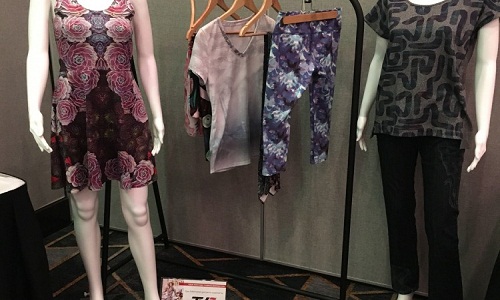
Members of the digital textile printing industry gathered in Durham, North Carolina, December 5-6 for the third annual “Digital Textile Printing Conference 3.0” hosted by the American Association of Textile Chemists and Colorists (AATCC) and SGIA. The “forum for collaboration” covered the current digital textile print market including digital textile design; color management, sampling, and digital workflow; technology and ink; and digital manufacturing and integration.
While screen printing is still seen as the dominant technology utilized in the textiles market, 371.4 billion square feet of digitally printed textiles have sold worldwide, said Duncan Ross, AVA CAD/CAM Group. And that number is destined to rise exponentially as printers and designers understand the value of digital print, from increased ROI to customizable, visually appealing designs to green practices.
Here’s what a few of the speakers had to say about digital print’s benefits:
“When you print digitally, you have higher volumes and a much higher profit margin,” said Mark Hanley, IT Strategies.
“Digital textile printing allows for endless rich and vivid design options, a number of colors without limitation, and multiple fabric types with the same inkset,” said Sharon Donovich, Kornit Digital. “Plus, it’s a 100-percent sustainable solution, and offers a fast learning curve and a clean chemical-free work environment for employees.”
“The benefits to digital textile printing include sustainability, high speed, and print on demand,” said Debbie McKeegan, TexIntel.
“Digital platforms can dramatically compress timelines. Results: decreased labor cost, increased responsiveness, reduced frustration, and higher close rates,” said J. Flint Davis, WeaveUp.
The Specifics
Another major benefit? Customization. Digital allows for short runs of whatever carefully crafted or person-specific design a customer wants. Kristen Dettoni, Design Pool and Pattern Pod, broached the much-talked-about topic in the best possible way, with a scene from the iconic film “When Harry Met Sally...” Sally’s order goes like this: “I'd like the chef salad, please, with the oil and vinegar on the side. And the apple pie a la mode… But I'd like the pie heated, and I don't want the ice cream on top. I want it on the side. And I'd like strawberry instead of vanilla if you have it. If not, then no ice cream, just whipped cream, but only if it's real. If it's out of a can, then nothing.” And her character wasn’t even a millennial! Some people just want it how they want it. And digital print allows for that.
customer wants. Kristen Dettoni, Design Pool and Pattern Pod, broached the much-talked-about topic in the best possible way, with a scene from the iconic film “When Harry Met Sally...” Sally’s order goes like this: “I'd like the chef salad, please, with the oil and vinegar on the side. And the apple pie a la mode… But I'd like the pie heated, and I don't want the ice cream on top. I want it on the side. And I'd like strawberry instead of vanilla if you have it. If not, then no ice cream, just whipped cream, but only if it's real. If it's out of a can, then nothing.” And her character wasn’t even a millennial! Some people just want it how they want it. And digital print allows for that.
“The market now is ‘I want it how I want it,’” Dettoni said . “Brands in the textiles market allow for customization through micro manufacturing, flexible pricing, flexible sizing, and flexible automation.”
“Customer attitudes are fueling growth in customization. Millennials really like to tell a story with a product, so they’re seeking uniqueness,” Davis said. Think about what Big Picture has talked about before: Instagrammable and selfie worthy. They’re also willing to pay a premium. “More than 80 percent of consumers are willing to pay 10-15 percent more for a customized product,” Davis said.
“The footwear market is so successful because they embrace a disruptive technology. Think knit tops and 3D-printed bottoms, all customizable,” said Will Duncan, Seams, the association for the US sewn products industry.
First Things First
As printers, we focus largely on how to print on textiles. But how much do we know about actually designing for digitally printed textiles? McKeegan’s answer to addressing the first major step in the production process is understanding the textile technology. “The design to production cycle time today is instant: design, process, prepress, print ready,” she said. “However, working with multiple media across processes has its challenges.”
And as much as this industry is now accessible to wide-format PSPs, textile designers now have the capability to purchase machines and print in-house. “We’ve totally democratized print. Everything is online, whether it’s fast fashion, design, or interiors,” she said. “Print has become available to all, and the marketplace has shifted to customization. Designers are now migrating from fashion to interiors, to graphics and events because of digital print.” How will your shop adjust to a possible increase in competition?












